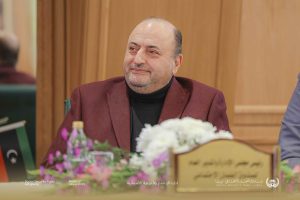Introducing the Military Retirement Administration
As stipulated in the decree of the Social Security Fund Administration Committee No. (11) for the year (2010 AD) regarding the issuance of the internal administrative regulation of the Social Security Fund and its branches and offices, the Military Retirement Department is one of the departments that report directly to the Fund’s Chairman of Board of Directors.
This administration includes three departments:
- Pensions Department.
- Rewards Department.
- Archive and Documentation Department.
The Military Retirement Department is concerned with the implementation of Military Retirement Law No. (43) for the year 1974 AD, its amendments, the regulations, and decisions issued thereunder.
A historical overview of Law No. (43) of (1974 AD) regarding military retirement:
A number of laws were issued prior to the issuance of this law
- Law No. (43) of 1974, the most important of which was the Law of Service in the Armed Forces.
- Law No. (40) for the year 1974 AD, it regulates the conditions of army personnel during military service with regard to their ranks, types of military service, promotions, leave, and everything related to military service.
- Law No. (43) for the year 1974 AD regarding the retirement of the military, specifically on 27 July 1974 AD, where the provisions of this law apply to the soldiers present in the armed forces at the time of its enforcement or who join afterwards, under this law, the provisions of Chapter Five of the General Retirement Law for the year 1967 AD were repealed.
Then the decision of the Minister of Social Affairs and Social Security was issued concerning the implementation of Military Retirement Law No. (43) for the year 1974 AD, dated January 14, 1975 AD.
The provisions of this law apply to:
A. Officers who serve in the armed forces on a permanent basis, provided for They are in the law of service in the armed forces.
B. Non-commissioned officers and volunteer soldiers.
The provisions of this law do not apply to the recruited by compulsion or assigned, those called up from reserve or retirement, members of the public resistance, students of military colleges and institutes, and civilians working in the armed forces, except within borders and in the cases in which it is expressly provided for.
This law organized the conditions of the military who benefit from it in nine chapters as follows:
Chapter One: The Basic Provisions, where the scope of its applicability is clarified in its articles.
Chapter Two: General retirement treatment, as the articles of this chapter are clarified when retired military are entitled a pension, and when are entitled to a reward only, in addition to cases of postponing retirement, and what they are entitled to in the event of resignation from military service.
Chapter Three: Pension treatment due to death or lack of health, as the articles of this chapter stipulate what the military are entitled to in cases of disability, injury, and death, whether during service, due to service, or outside military service and not due to it, and partial disability; when the disability is considered total or partial.
Chapter Four: retirement treatment in Cases of Martyrdom, Loss, and Injury in Military Operations, this chapter specializes in how to disburse the pension to the families of the martyr and the missing and their beneficiaries.
Chapter Five: Compensation for people with a disability that does not prevent them from continuing their service.
Chapter Six: retirement treatment for recruits, commissioned, or recalled from reserve or retirement, members of the public resistance and civilians working in the armed forces.
Chapter Seven: Treatment of students in military colleges, institutes, and educational establishments, as this section explains the treatment of students whom are martyred, lost, or injured in military operations because of their service.
Chapter Eight: Those entitled to a pension or a benefit on behalf of the beneficiary. This chapter clarifies who are entitled to a military retirement pension, how the pension or benefit is paid to them, and the percentage of entitlement for each one of them, based on the list of beneficiaries.
Chapter Nine: Proving Health Inadequacy and Death. This chapter tackles proof of injury, disability, or death, and how to present it to military medical committees; when the medical committee decides unfit, and how to prove injury or death in remote places and outside the country.
Laws and Decisions Subsequent to the Promulgation of Law No. (43) of (1974 AD) Concerning Military Retirement: several laws were issued by the Supreme Commander of the Armed Forces, according to Law No. (9) of 1981 AD regarding authorizing the Supreme Commander of the Armed Forces to issue military laws, Where Law No. (6) of 1985 was issued amending the text of Articles (23/26) of Law No. (43/1974 AD).
Under that mandate, Law No. 3 of 1988 was issued regarding amending the text of Article (20) of Law No. (43/1974), where it specified the period of military service whose holders are entitled to a military retirement pension in the event of a disability of twenty-five years. A very large number of disputes were raised before the dispute committees in the various branches of the Fund regarding this law, and they were appealed before the Administrative Appeal Courts. The constitutionality of this law was appealed before the Supreme Court in Constitutional Appeal No. (1/55 BC), where the Supreme Court ruled on ((11/11). 2009) and its constituencies meeting the constitutionality of this law, rejecting the submitted appeal, and canceling the pensions that were spent in violation of this law.
And in the year (1991 AD) Law No. (12 of 1991 AD) was issued regarding determining the rights and benefits of those who lost their lives from the military and civilians during the performance of duty. Old age, which is stipulated in the provisions of the Military Pension Law, deprives them of the benefits of a martyr’s pension, as well as the benefits of entitlement that were distinguished in Article (60) of the Military Retirement Law, who are eligible for martyrs.
Several decisions were issued by the General People’s Committee regarding this law, then the General People’s Committee Resolution No. (214) of 2008 was issued approving a financial increase for the salaries of the armed public affiliates, as they asked the military retirees to benefit from this decision “and they raised disputes that ended in their entirety giving the right to retirees to benefit From this decision, “the appeals are still filed before the Administrative Appeal Courts to challenge the cancellation of the decisions of the dispute committees in particular, but some of the case management branches (Benghazi branch – Fezzan branch) have returned the appeals to the Social Security Fund administration on the pretext of the futility of filing the appeal for the possibility of non-earning, as this matter has created a kind of controversy among the legalists in the fund’s branches. Several decisions to report an increase in the various salaries, all issued by the General public’s Committee, including Resolution No. (29) of 2011, which stipulated the following (a financial increase shall be added to the salaries of members of the armed people in the amount of 100 hundred dinars).
After the victory of the glorious February 17 revolution, Law No. 1 of 2012 was issued defining some provisions regarding the salaries of the military. 1974), which was abolished by Law No. 3/1988, and this law is blamed for not treating the category of military retirees whose services were terminated in light of the General Retirement Law of 1967 and the Military Retirement Law No. 43/1974, with the inability of Article 4 of it to address debts related to the rest of the pensions. Where it spoke on the retirement age of the military only.







